Reflection: TESOL Course - Learning and Teaching English in Australia
VerifiedAdded on 2022/09/12
|6
|1515
|25
Report
AI Summary
This reflection paper explores the author's journey as a learner and teacher of English to non-English speaking students in Australia. The paper begins with a personal account of language learning experiences, including a German class in high school and interactions with Arabic-speaking friends, highlighting the challenges and insights gained. It then delves into the principles, approaches, and conditions essential for effective TESOL practices, emphasizing the importance of student motivation and teacher methods. The author contrasts the series method with the direct method, advocating for the latter's use of songs, fables, and oral narratives. The paper concludes with a vision for integrating theoretical ideals with practical teaching methods, particularly in the Australian context, aiming to create a positive learning environment for students. References to relevant literature on TESOL are also provided, supporting the arguments presented in the reflection.

Running head:REFLECTION: TESOL 1
Reflection: TESOL
Name
Institution
Reflection: TESOL
Name
Institution
Paraphrase This Document
Need a fresh take? Get an instant paraphrase of this document with our AI Paraphraser
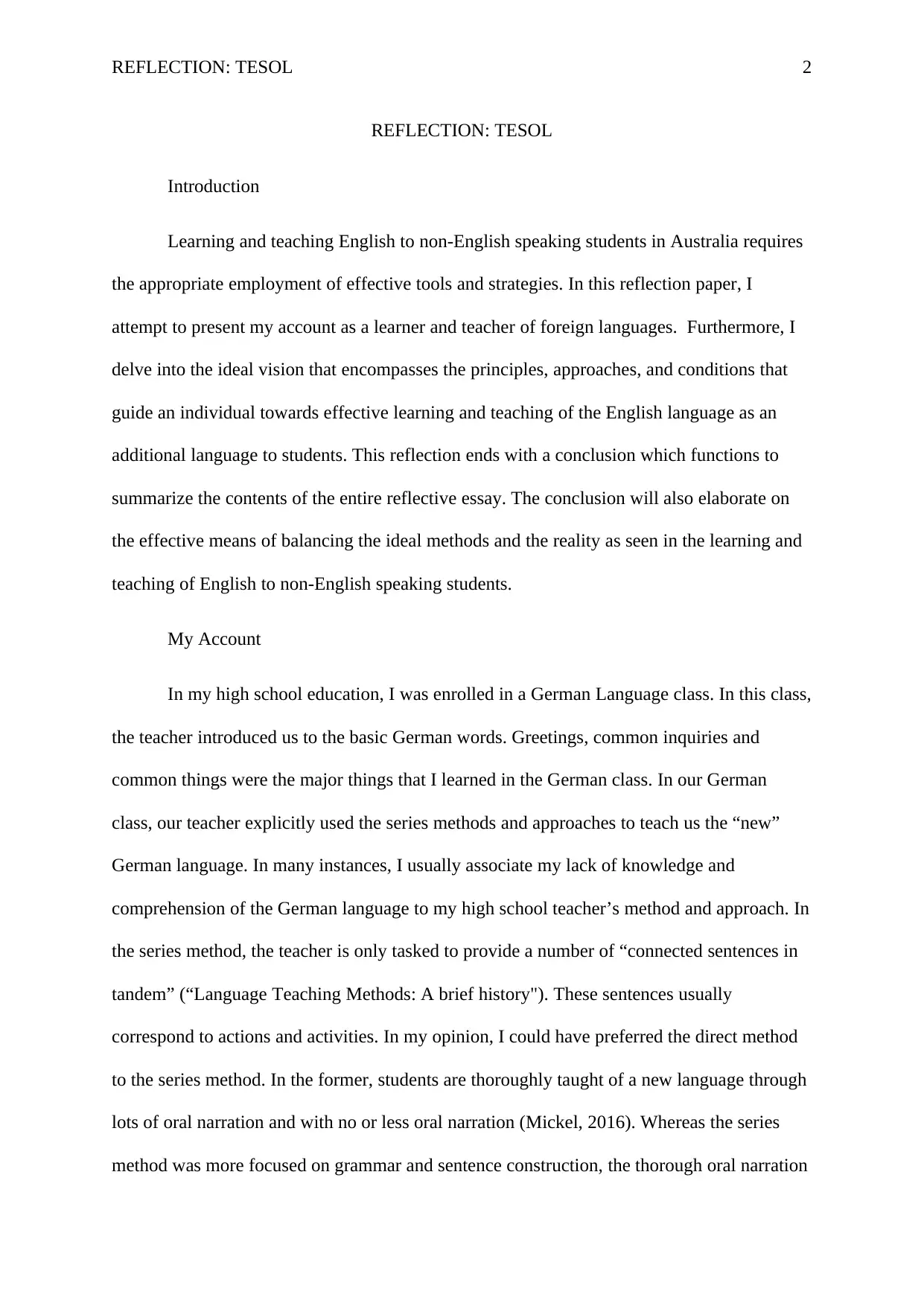
REFLECTION: TESOL 2
REFLECTION: TESOL
Introduction
Learning and teaching English to non-English speaking students in Australia requires
the appropriate employment of effective tools and strategies. In this reflection paper, I
attempt to present my account as a learner and teacher of foreign languages. Furthermore, I
delve into the ideal vision that encompasses the principles, approaches, and conditions that
guide an individual towards effective learning and teaching of the English language as an
additional language to students. This reflection ends with a conclusion which functions to
summarize the contents of the entire reflective essay. The conclusion will also elaborate on
the effective means of balancing the ideal methods and the reality as seen in the learning and
teaching of English to non-English speaking students.
My Account
In my high school education, I was enrolled in a German Language class. In this class,
the teacher introduced us to the basic German words. Greetings, common inquiries and
common things were the major things that I learned in the German class. In our German
class, our teacher explicitly used the series methods and approaches to teach us the “new”
German language. In many instances, I usually associate my lack of knowledge and
comprehension of the German language to my high school teacher’s method and approach. In
the series method, the teacher is only tasked to provide a number of “connected sentences in
tandem” (“Language Teaching Methods: A brief history"). These sentences usually
correspond to actions and activities. In my opinion, I could have preferred the direct method
to the series method. In the former, students are thoroughly taught of a new language through
lots of oral narration and with no or less oral narration (Mickel, 2016). Whereas the series
method was more focused on grammar and sentence construction, the thorough oral narration
REFLECTION: TESOL
Introduction
Learning and teaching English to non-English speaking students in Australia requires
the appropriate employment of effective tools and strategies. In this reflection paper, I
attempt to present my account as a learner and teacher of foreign languages. Furthermore, I
delve into the ideal vision that encompasses the principles, approaches, and conditions that
guide an individual towards effective learning and teaching of the English language as an
additional language to students. This reflection ends with a conclusion which functions to
summarize the contents of the entire reflective essay. The conclusion will also elaborate on
the effective means of balancing the ideal methods and the reality as seen in the learning and
teaching of English to non-English speaking students.
My Account
In my high school education, I was enrolled in a German Language class. In this class,
the teacher introduced us to the basic German words. Greetings, common inquiries and
common things were the major things that I learned in the German class. In our German
class, our teacher explicitly used the series methods and approaches to teach us the “new”
German language. In many instances, I usually associate my lack of knowledge and
comprehension of the German language to my high school teacher’s method and approach. In
the series method, the teacher is only tasked to provide a number of “connected sentences in
tandem” (“Language Teaching Methods: A brief history"). These sentences usually
correspond to actions and activities. In my opinion, I could have preferred the direct method
to the series method. In the former, students are thoroughly taught of a new language through
lots of oral narration and with no or less oral narration (Mickel, 2016). Whereas the series
method was more focused on grammar and sentence construction, the thorough oral narration
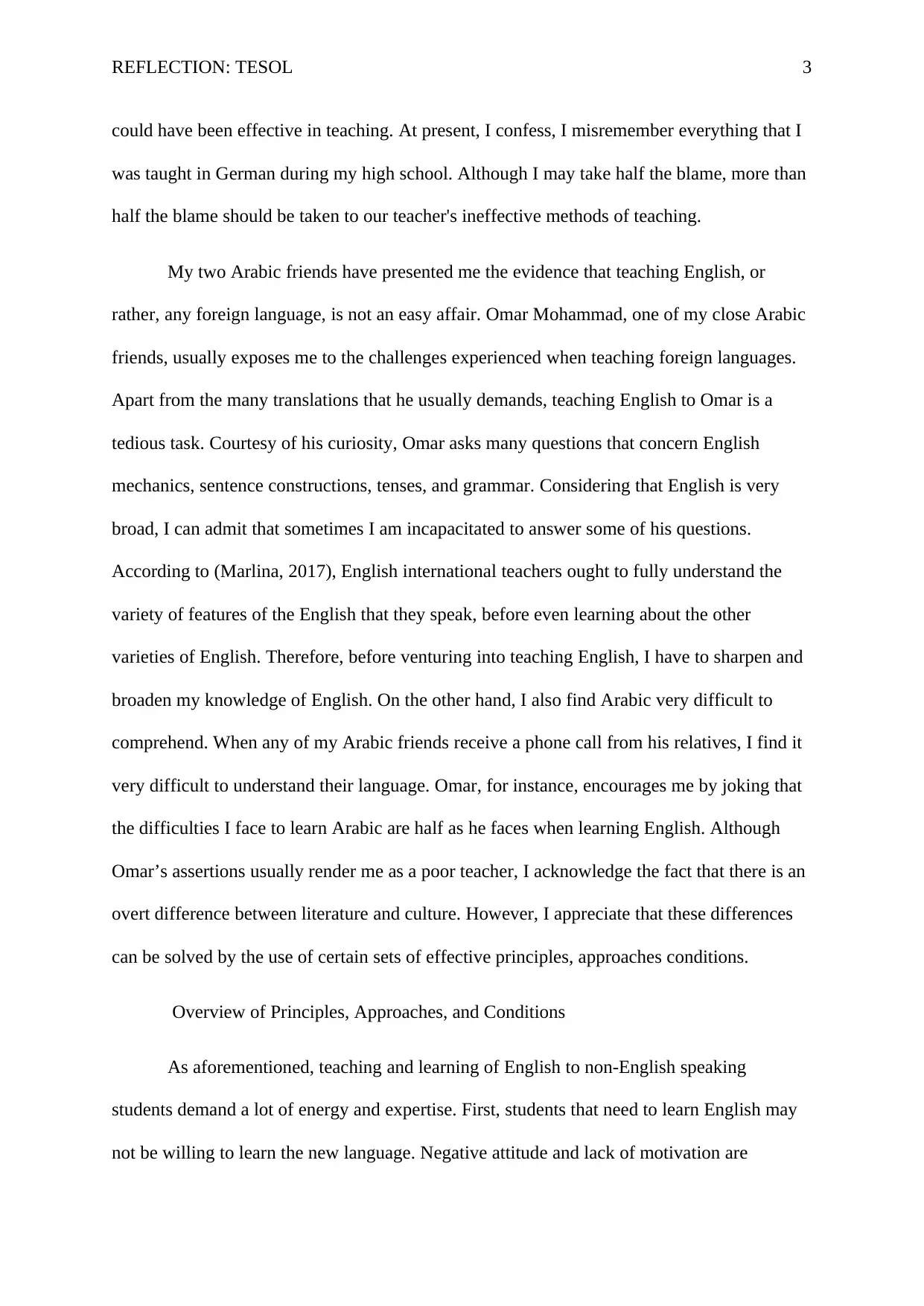
REFLECTION: TESOL 3
could have been effective in teaching. At present, I confess, I misremember everything that I
was taught in German during my high school. Although I may take half the blame, more than
half the blame should be taken to our teacher's ineffective methods of teaching.
My two Arabic friends have presented me the evidence that teaching English, or
rather, any foreign language, is not an easy affair. Omar Mohammad, one of my close Arabic
friends, usually exposes me to the challenges experienced when teaching foreign languages.
Apart from the many translations that he usually demands, teaching English to Omar is a
tedious task. Courtesy of his curiosity, Omar asks many questions that concern English
mechanics, sentence constructions, tenses, and grammar. Considering that English is very
broad, I can admit that sometimes I am incapacitated to answer some of his questions.
According to (Marlina, 2017), English international teachers ought to fully understand the
variety of features of the English that they speak, before even learning about the other
varieties of English. Therefore, before venturing into teaching English, I have to sharpen and
broaden my knowledge of English. On the other hand, I also find Arabic very difficult to
comprehend. When any of my Arabic friends receive a phone call from his relatives, I find it
very difficult to understand their language. Omar, for instance, encourages me by joking that
the difficulties I face to learn Arabic are half as he faces when learning English. Although
Omar’s assertions usually render me as a poor teacher, I acknowledge the fact that there is an
overt difference between literature and culture. However, I appreciate that these differences
can be solved by the use of certain sets of effective principles, approaches conditions.
Overview of Principles, Approaches, and Conditions
As aforementioned, teaching and learning of English to non-English speaking
students demand a lot of energy and expertise. First, students that need to learn English may
not be willing to learn the new language. Negative attitude and lack of motivation are
could have been effective in teaching. At present, I confess, I misremember everything that I
was taught in German during my high school. Although I may take half the blame, more than
half the blame should be taken to our teacher's ineffective methods of teaching.
My two Arabic friends have presented me the evidence that teaching English, or
rather, any foreign language, is not an easy affair. Omar Mohammad, one of my close Arabic
friends, usually exposes me to the challenges experienced when teaching foreign languages.
Apart from the many translations that he usually demands, teaching English to Omar is a
tedious task. Courtesy of his curiosity, Omar asks many questions that concern English
mechanics, sentence constructions, tenses, and grammar. Considering that English is very
broad, I can admit that sometimes I am incapacitated to answer some of his questions.
According to (Marlina, 2017), English international teachers ought to fully understand the
variety of features of the English that they speak, before even learning about the other
varieties of English. Therefore, before venturing into teaching English, I have to sharpen and
broaden my knowledge of English. On the other hand, I also find Arabic very difficult to
comprehend. When any of my Arabic friends receive a phone call from his relatives, I find it
very difficult to understand their language. Omar, for instance, encourages me by joking that
the difficulties I face to learn Arabic are half as he faces when learning English. Although
Omar’s assertions usually render me as a poor teacher, I acknowledge the fact that there is an
overt difference between literature and culture. However, I appreciate that these differences
can be solved by the use of certain sets of effective principles, approaches conditions.
Overview of Principles, Approaches, and Conditions
As aforementioned, teaching and learning of English to non-English speaking
students demand a lot of energy and expertise. First, students that need to learn English may
not be willing to learn the new language. Negative attitude and lack of motivation are
⊘ This is a preview!⊘
Do you want full access?
Subscribe today to unlock all pages.

Trusted by 1+ million students worldwide
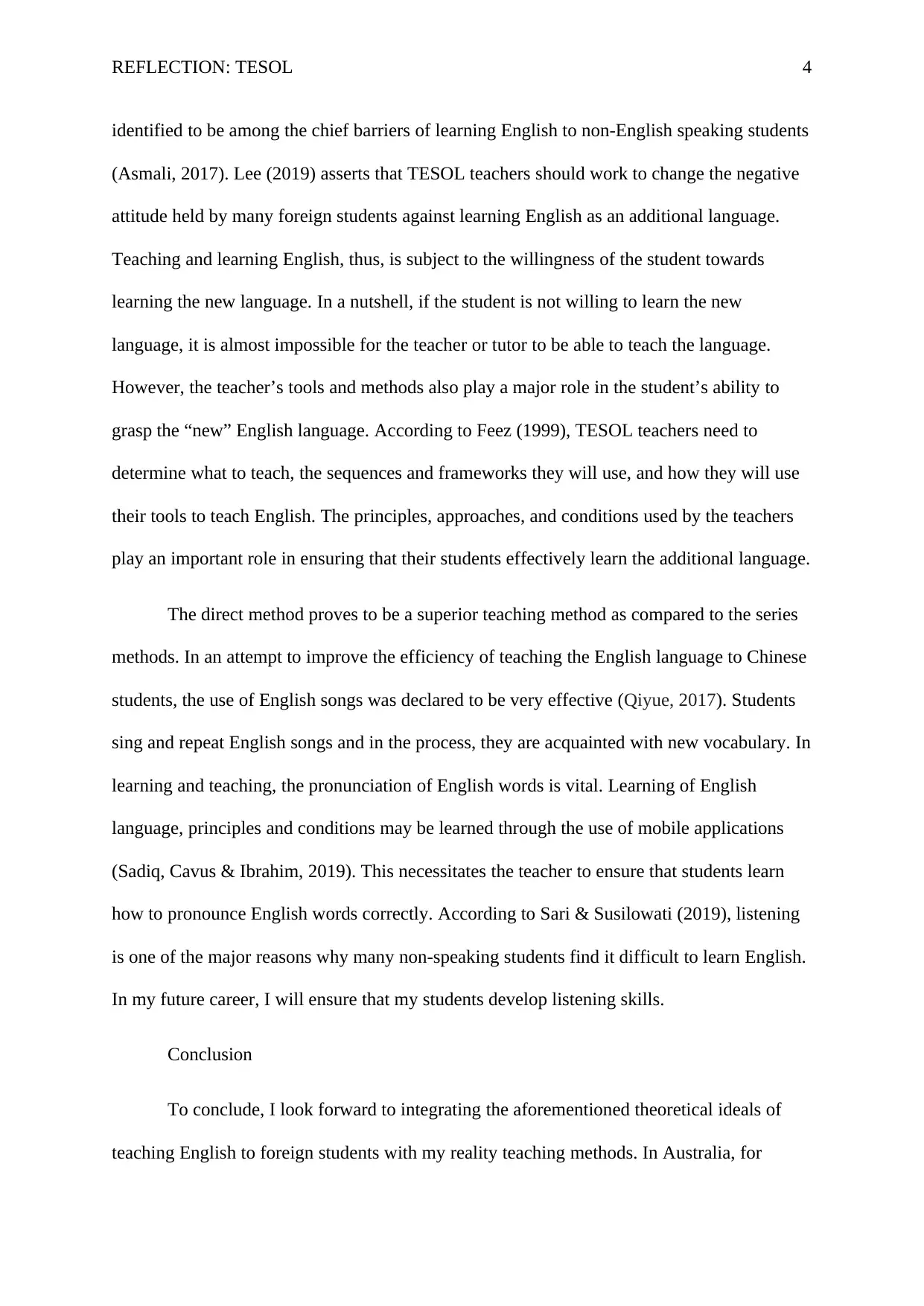
REFLECTION: TESOL 4
identified to be among the chief barriers of learning English to non-English speaking students
(Asmali, 2017). Lee (2019) asserts that TESOL teachers should work to change the negative
attitude held by many foreign students against learning English as an additional language.
Teaching and learning English, thus, is subject to the willingness of the student towards
learning the new language. In a nutshell, if the student is not willing to learn the new
language, it is almost impossible for the teacher or tutor to be able to teach the language.
However, the teacher’s tools and methods also play a major role in the student’s ability to
grasp the “new” English language. According to Feez (1999), TESOL teachers need to
determine what to teach, the sequences and frameworks they will use, and how they will use
their tools to teach English. The principles, approaches, and conditions used by the teachers
play an important role in ensuring that their students effectively learn the additional language.
The direct method proves to be a superior teaching method as compared to the series
methods. In an attempt to improve the efficiency of teaching the English language to Chinese
students, the use of English songs was declared to be very effective (Qiyue, 2017). Students
sing and repeat English songs and in the process, they are acquainted with new vocabulary. In
learning and teaching, the pronunciation of English words is vital. Learning of English
language, principles and conditions may be learned through the use of mobile applications
(Sadiq, Cavus & Ibrahim, 2019). This necessitates the teacher to ensure that students learn
how to pronounce English words correctly. According to Sari & Susilowati (2019), listening
is one of the major reasons why many non-speaking students find it difficult to learn English.
In my future career, I will ensure that my students develop listening skills.
Conclusion
To conclude, I look forward to integrating the aforementioned theoretical ideals of
teaching English to foreign students with my reality teaching methods. In Australia, for
identified to be among the chief barriers of learning English to non-English speaking students
(Asmali, 2017). Lee (2019) asserts that TESOL teachers should work to change the negative
attitude held by many foreign students against learning English as an additional language.
Teaching and learning English, thus, is subject to the willingness of the student towards
learning the new language. In a nutshell, if the student is not willing to learn the new
language, it is almost impossible for the teacher or tutor to be able to teach the language.
However, the teacher’s tools and methods also play a major role in the student’s ability to
grasp the “new” English language. According to Feez (1999), TESOL teachers need to
determine what to teach, the sequences and frameworks they will use, and how they will use
their tools to teach English. The principles, approaches, and conditions used by the teachers
play an important role in ensuring that their students effectively learn the additional language.
The direct method proves to be a superior teaching method as compared to the series
methods. In an attempt to improve the efficiency of teaching the English language to Chinese
students, the use of English songs was declared to be very effective (Qiyue, 2017). Students
sing and repeat English songs and in the process, they are acquainted with new vocabulary. In
learning and teaching, the pronunciation of English words is vital. Learning of English
language, principles and conditions may be learned through the use of mobile applications
(Sadiq, Cavus & Ibrahim, 2019). This necessitates the teacher to ensure that students learn
how to pronounce English words correctly. According to Sari & Susilowati (2019), listening
is one of the major reasons why many non-speaking students find it difficult to learn English.
In my future career, I will ensure that my students develop listening skills.
Conclusion
To conclude, I look forward to integrating the aforementioned theoretical ideals of
teaching English to foreign students with my reality teaching methods. In Australia, for
Paraphrase This Document
Need a fresh take? Get an instant paraphrase of this document with our AI Paraphraser
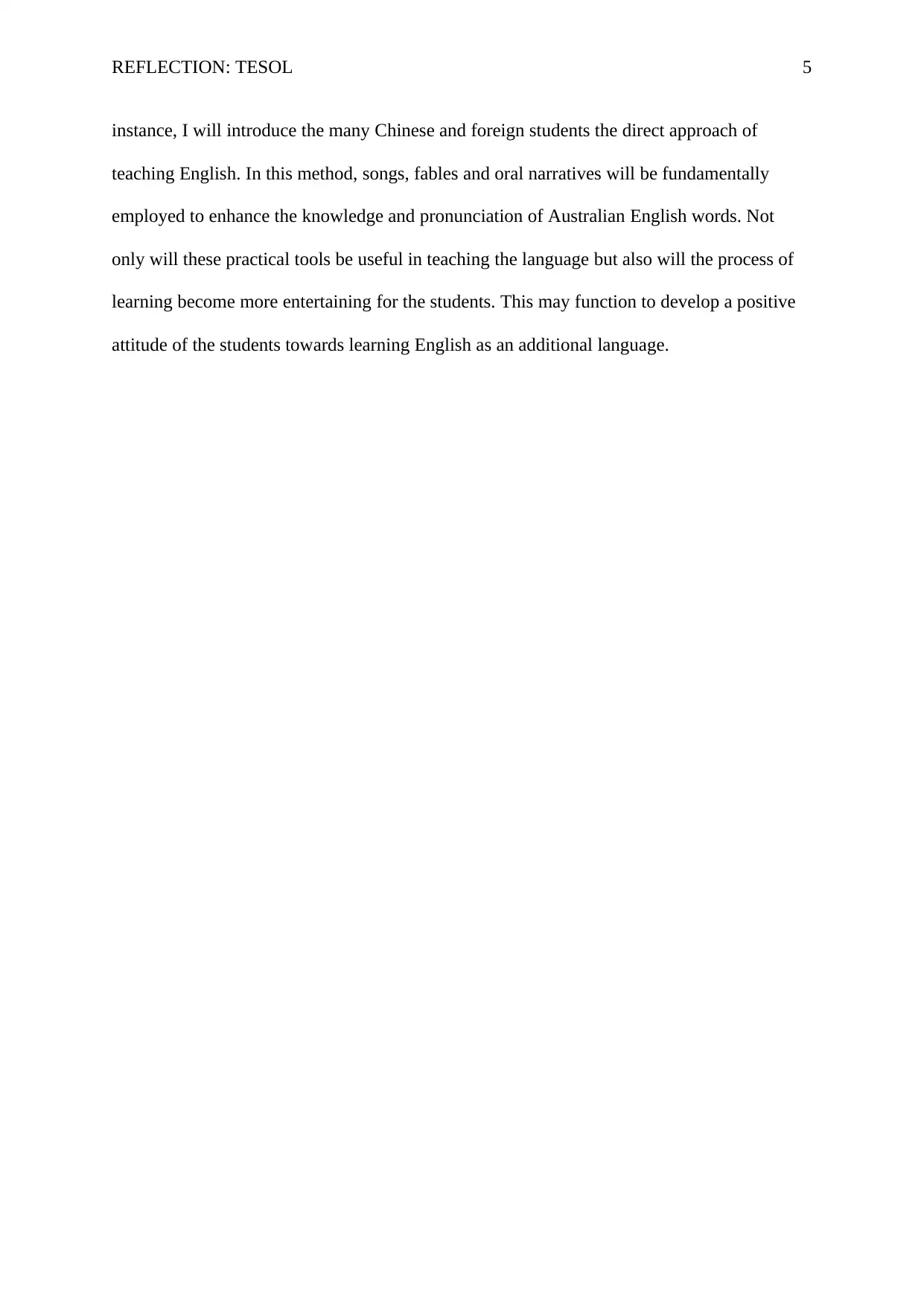
REFLECTION: TESOL 5
instance, I will introduce the many Chinese and foreign students the direct approach of
teaching English. In this method, songs, fables and oral narratives will be fundamentally
employed to enhance the knowledge and pronunciation of Australian English words. Not
only will these practical tools be useful in teaching the language but also will the process of
learning become more entertaining for the students. This may function to develop a positive
attitude of the students towards learning English as an additional language.
instance, I will introduce the many Chinese and foreign students the direct approach of
teaching English. In this method, songs, fables and oral narratives will be fundamentally
employed to enhance the knowledge and pronunciation of Australian English words. Not
only will these practical tools be useful in teaching the language but also will the process of
learning become more entertaining for the students. This may function to develop a positive
attitude of the students towards learning English as an additional language.
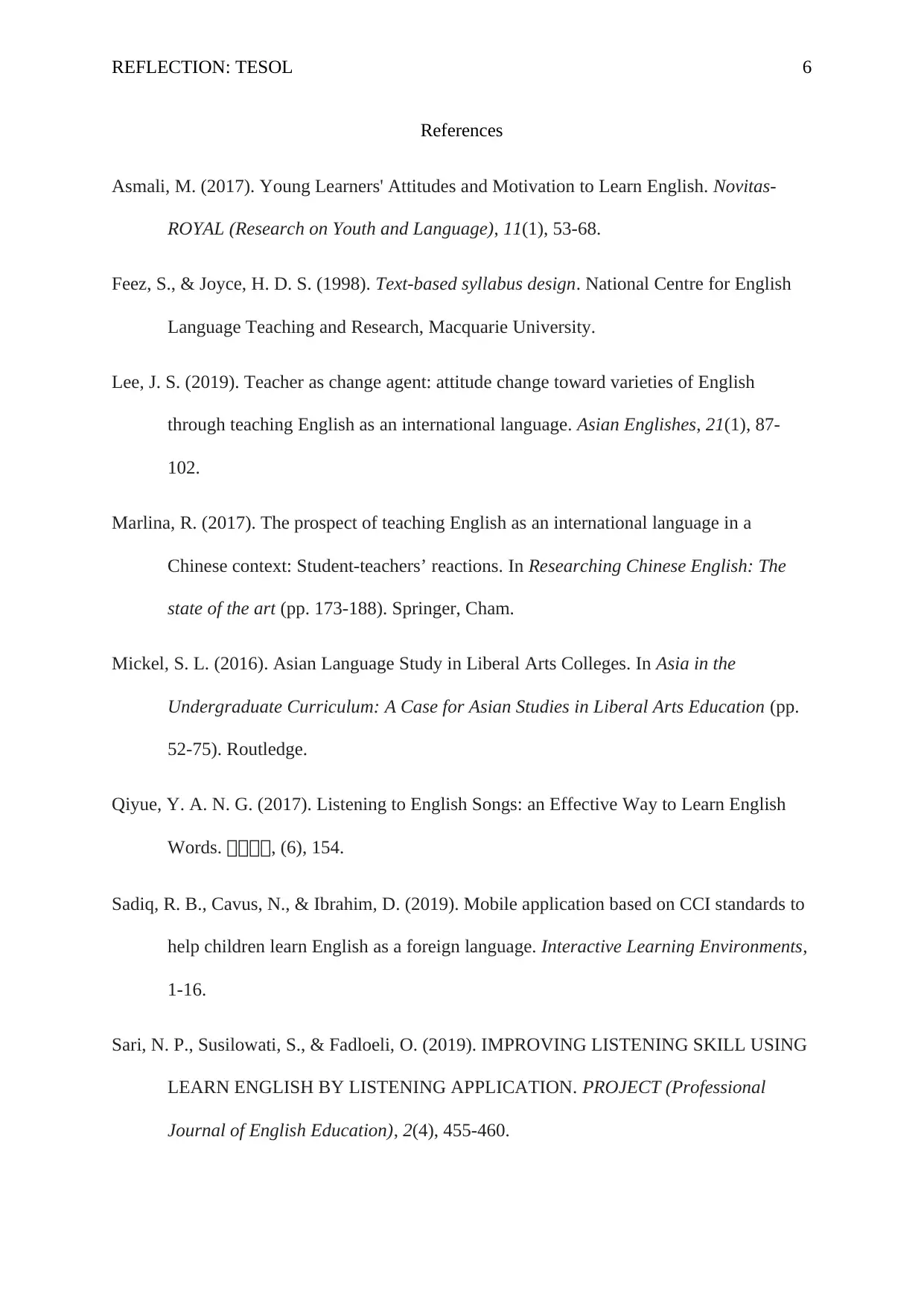
REFLECTION: TESOL 6
References
Asmali, M. (2017). Young Learners' Attitudes and Motivation to Learn English. Novitas-
ROYAL (Research on Youth and Language), 11(1), 53-68.
Feez, S., & Joyce, H. D. S. (1998). Text-based syllabus design. National Centre for English
Language Teaching and Research, Macquarie University.
Lee, J. S. (2019). Teacher as change agent: attitude change toward varieties of English
through teaching English as an international language. Asian Englishes, 21(1), 87-
102.
Marlina, R. (2017). The prospect of teaching English as an international language in a
Chinese context: Student-teachers’ reactions. In Researching Chinese English: The
state of the art (pp. 173-188). Springer, Cham.
Mickel, S. L. (2016). Asian Language Study in Liberal Arts Colleges. In Asia in the
Undergraduate Curriculum: A Case for Asian Studies in Liberal Arts Education (pp.
52-75). Routledge.
Qiyue, Y. A. N. G. (2017). Listening to English Songs: an Effective Way to Learn English
Words. 校校校校, (6), 154.
Sadiq, R. B., Cavus, N., & Ibrahim, D. (2019). Mobile application based on CCI standards to
help children learn English as a foreign language. Interactive Learning Environments,
1-16.
Sari, N. P., Susilowati, S., & Fadloeli, O. (2019). IMPROVING LISTENING SKILL USING
LEARN ENGLISH BY LISTENING APPLICATION. PROJECT (Professional
Journal of English Education), 2(4), 455-460.
References
Asmali, M. (2017). Young Learners' Attitudes and Motivation to Learn English. Novitas-
ROYAL (Research on Youth and Language), 11(1), 53-68.
Feez, S., & Joyce, H. D. S. (1998). Text-based syllabus design. National Centre for English
Language Teaching and Research, Macquarie University.
Lee, J. S. (2019). Teacher as change agent: attitude change toward varieties of English
through teaching English as an international language. Asian Englishes, 21(1), 87-
102.
Marlina, R. (2017). The prospect of teaching English as an international language in a
Chinese context: Student-teachers’ reactions. In Researching Chinese English: The
state of the art (pp. 173-188). Springer, Cham.
Mickel, S. L. (2016). Asian Language Study in Liberal Arts Colleges. In Asia in the
Undergraduate Curriculum: A Case for Asian Studies in Liberal Arts Education (pp.
52-75). Routledge.
Qiyue, Y. A. N. G. (2017). Listening to English Songs: an Effective Way to Learn English
Words. 校校校校, (6), 154.
Sadiq, R. B., Cavus, N., & Ibrahim, D. (2019). Mobile application based on CCI standards to
help children learn English as a foreign language. Interactive Learning Environments,
1-16.
Sari, N. P., Susilowati, S., & Fadloeli, O. (2019). IMPROVING LISTENING SKILL USING
LEARN ENGLISH BY LISTENING APPLICATION. PROJECT (Professional
Journal of English Education), 2(4), 455-460.
⊘ This is a preview!⊘
Do you want full access?
Subscribe today to unlock all pages.

Trusted by 1+ million students worldwide
1 out of 6
Related Documents
Your All-in-One AI-Powered Toolkit for Academic Success.
+13062052269
info@desklib.com
Available 24*7 on WhatsApp / Email
![[object Object]](/_next/static/media/star-bottom.7253800d.svg)
Unlock your academic potential
Copyright © 2020–2025 A2Z Services. All Rights Reserved. Developed and managed by ZUCOL.





